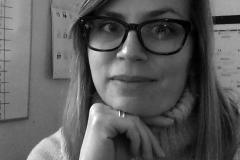Editorial, Function/Architecture
When I think of architecture, I think of buildings, as probably most people do. That may have something to do with the fact that any dictionary’s standard definition is something like, “the art or practice of designing and constructing buildings.” (Yes, the dictionaries consulted were actual, physical, bound volumes with pages, not just .com versions!)
In assigning “architecture” (with the additional prompt of “function”) to this issue of Studio Potter, my aim was to broaden that definition, exploring how it might not only include buildings, but also all kinds of other things: pots (duh), sculpture, even intangibles like ideas, or the future. Delving into my research – OK, technically my intern’s research – I discovered Eliel Saarinen’s 1948 book, The Search for Form in Art and Architecture. Saarinen (1873-1950) was an accomplished Finnish architect, whose book I probably would have read sooner had I attended Cranbrook Academy of Art, as he was the chief architect for the entire campus, located in Bloomfield Hills, Michigan. In The Search for Form, he discusses architecture as the “art of space.”
Space […] means not only the inside space embraced by the structure but that space embracing the structure as well. Namely, there can be imagined a certain “concavity” of space enclosing the pyramids, towers, monuments, and what have you. With these two space conceptions - within and without - architecture must be understood. […]
Sculpture also belongs to the art of space, at least insofar as the embracing “concavity” of space is concerned. […] And the “art of color” is more than a flat surface covered by color – for nobody looks at a painting with his nose tight to the canvas but always maintains a certain distance between the painting and his eyes. Thus even the art of painting has its “concavity” – if you please – within which its influence vibrates. […] And the vibrations of music do not stick to the strings of the violin but fill the surrounding space with their melody.
Thus form, whatever the means of expression, always must be understood in connection with space. And this so-called embracing “concavity” – and why not “convexity” as well – is nothing else than the sphere of light, shadow, and atmospheric effects within which form must be conceived, and within which form exerts its influence.
I’ve fallen in love with Saarinen’s take on architecture; the idea that even as a painter, your choices about the size of your canvas, brightness of hue, or broadness of brushstroke actually design the space in which people experience your creative vision. Though seemingly invisible, space has a language vital to its visual, and sometimes tactile counterpart.
In terms of pottery, well, maybe this idea isn’t novel, as one of the first requirements for a pot is a balance between the interior and exterior that allows for an optimal volume to overall weight (aesthetic or actual) ratio. If a pot requires Popeye’s arms to lift when full of liquid, we’ve learned something about interior space. If it doesn’t fit inside the cupboard, or has all the visual weight of a cow pie on the dining table, then we have learned some lessons about pots and domestic space.
Successful artistic expression, in any medium – painting, sculpture, utilitarian design, dance, music – and on any scale, requires careful consideration of not only the thing, but the spaces in which it is experienced by others. Often the experience of a space or place far outweighs the importance of the objects or material that define it. In fact, most of the stories in this issue are not so much about brick sidewalks, Islamic mosques, terra cotta facades, Scandinavian kilns, or plaster molds as they are about creating vibrant spaces within which we learn, pray, eat, work, and make.

